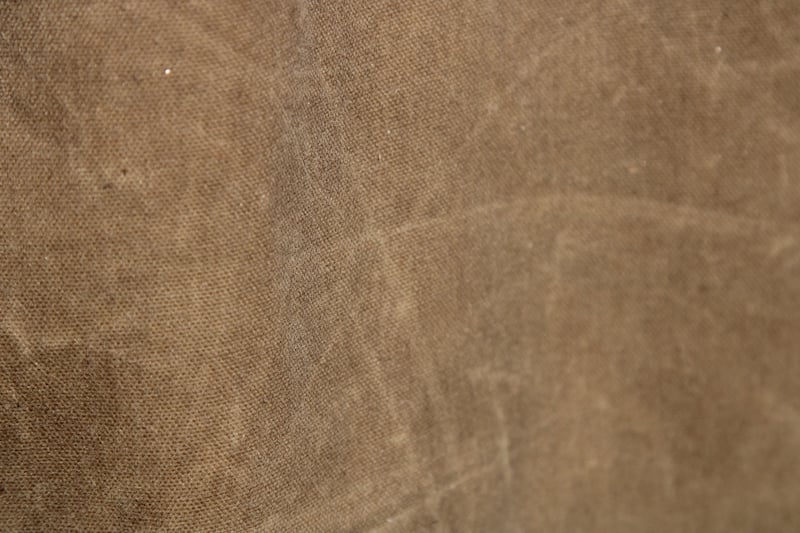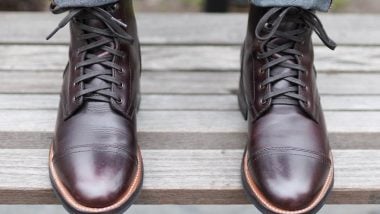Is Waxed Cotton Breathable? Everything You Need to Know
Waxed cotton has been the go-to fabric for waterproof — well, water-resistant — clothing for centuries. But is waxed cotton still a good choice in the modern era?
Well, yes. Waxed canvas — if cotton is getting waxed it’s usually canvas, sometimes twill, but we’re talking about waxed cotton in general — is pretty darn waterproof.
Key Takeaways:
But no, waxed cotton is not very breathable.
The difference between wearing an unwaxed and a waxed canvas jacket is like night and day. Cotton, of course, is fabulously breathable, and it’s a big part of why it’s the preferred material for summer shirting. But when you add a layer of wax to it, you make it less permeable. That’s the point: the wax adds a barrier to the cotton that keeps water out, but it makes it significantly less breathable.

Breathability: Waved Canvas vs Gore-Tex
If you’re comparing waxed canvas to a modern material like Gore-Tex, Gore-Tex has it beat for waterproofness and breathability. And flexibility and weight. (Sorry, heritage guys.)
But waxed canvas isn’t as bad as all that. Because microscopic holes in the canvas can allow water vapor (your sweat) to pass through while keeping large rain droplets out, some find a waxed canvas to breathe well enough. Just don’t expect it to feel like your high-tech, stretchy, waterproof technical jacket.
It also looks great, ages well is tear-resistant, and is very durable: if you take care of your waxed cotton garments properly, they can last for years and years. These are the main reasons a lot of people prefer it to modern materials like Gore-Tex, even though Gore-Tex is lighter and more flexible.
So, if you’re looking for a durable, cool-looking, and water-resistant fabric for your next outdoor adventure, waxed cotton may be the perfect choice for you.
A truly iconic waxed canvas jacket that's American made with American materials, it's perfect for work and play — plus it comes in 8+ colors and two fits.
What Is a Waxed Cotton Jacket?
A waxed cotton jacket is a type of fabric that is treated with wax, usually paraffin wax. This treatment makes the cotton water-resistant, and as a bonus, it makes for a great patina, meaning that it develops aesthetically pleasing creases and color permutations as it ages.
Waxed cotton jackets are often used for outdoor clothing and gear, such as jackets, hats, and backpacks. It is also popular for home decor items, such as curtains and upholstery.

Types Of Wax Used To Make Waterproof Clothing
Waxed cotton products are a very practical and stylish rainwear option in the cooler seasons.
What you might not know is that there are different kinds of wax used in making these kinds of garments. It doesn’t make much difference when it comes to fashion whether your waxed cotton garment uses one type of wax or another.
But when it comes to how long your garment will last, knowing which types of wax you have will give you an idea about how durable the wax coating is and how often you’ll need to reapply it. (You don’t have to reapply it as it wears away, of course, but you will if maintaining water resistance is your priority.)
If you’re trying to make your garment lasts as long as possible, it’s good to know which types of wax are used.
There are generally three different kinds of wax that are used in making waxed cotton clothing:
- carnauba wax (sourced from a Brazilian palm tree)
- paraffin (usually derived from petroleum)
- microcrystalline wax (also derived from petroleum but generally darker, tackier, and more heat resistant)
Of these three, the majority are made with paraffin. This is what most people think of when they hear “waxed cotton” because this type of material has been the go-to fabric for lighter cloth for decades.
[Related: Is Waxed Cotton Waterproof?]

This coating gives the fabric its water-resistant properties and also makes it easier to clean than other materials would be without it.
If you’re looking for a more environmentally friendly option and don’t mind sacrificing some of the water resistance, carnauba wax is a good choice. It’s made from the Brazilian palm tree and gives a natural sheen to fabrics. However, it doesn’t hold up as well to wear and tear as paraffin wax does.
The final option — microcrystalline wax — is a newer type of wax that was developed specifically for use on cotton fabrics. It’s very durable and resistant to both water and UV rays, making it a good choice for garments that will be exposed to the elements regularly, particularly as it’s more elastic. It is darker, more viscous, and stickier, however. Still, if you’re looking for a waxed cotton garment that will last you for years, microcrystalline wax may be the best option available to you.
A truly iconic waxed canvas jacket that's American made with American materials, it's perfect for work and play — plus it comes in 8+ colors and two fits.

How Wax Is Applied To Cotton
Applying wax to cotton is a centuries-old tradition that’s still used today to create water-resistant and durable fabrics. Many different methods can be used for waxing, but the most common is the immersion method.
This involves submerging the fabric material in a vat of hot wax and then agitating it until the desired level of saturation is achieved. After the fabric has been removed from the wax bath, it’s hung up to dry and then ironed so that the heat from the iron will help set the wax to melt and stay in place deep into the cotton fibers.
The different types of wax are applied to the fabric weave at different stages during this process, which is crucial to getting a high-quality garment out of your efforts. Paraffin wax is the most common choice for fabrics that are made using immersion methods, but carnauba wax can be used as well. If you’re applying microcrystalline wax to cotton, however, it must be applied after the fabric has been dried in the wind because it can’t be set with heat or a hair dryer to avoid turning it stiff.
All types of wax-coated fabrics are highly water-resistant when they are applied correctly, though again, carnauba wax has the added effect of making the fabric look shiny.
Microcrystalline wax is less effective than carnauba and paraffin when it comes to repelling water, but it’s much more durable and resistant to UV rays. So, if you’re looking for a waxed cotton garment that will withstand a lot of wear and tear, microcrystalline wax is the best option.
The application process (see the video above for tips) can be a little daunting at first, but with a little practice, you’ll be able to apply wax to cotton like a pro. Just make sure to follow the manufacturer’s instructions carefully and take your time with each step so that you get the best results possible.
And if you ever have any questions, don’t hesitate to ask a professional for help. Waxed cotton can be a great way to keep yourself dry and looking stylish during those unexpected downpours, but it’s important to know how to do it correctly to get the most out of your investment.

How To Care For Waxed Cotton
One of the great things about waxed cotton is that it doesn’t require a lot of special care. However, there are a few things you should keep in mind when caring for your waxed cotton wears:
- Never wash your jacket with warm or hot water. It’ll release the wax.
- Never use abrasive soaps.
- Don’t even use a washing machine; you need to spot-clean it.
Use a soft-bristled brush and cold water to remove stains — don’t add soap until you’re sure that water alone isn’t doing the trick. If you do use soap, ensure that it’s mild — and don’t use detergent. Then, you can simply rinse away any soap and allow the canvas to air dry. (Don’t put it in a dryer.)
[Related: The 10 Best Waxed Backpacks]

To Sum Up…
Cotton has been used for waterproofing purposes since at least the 1700s. Before the advent of modern waterproof synthetics, waxed cotton was the primary material used for rainwear.
There is very little maintenance required for these garments. A quick wipe-down with a damp cloth should also do the trick.
To readdress the title of the article: they aren’t the most breathable. What this means, practically, is that it’s not great when there’s a considerable variance in the temperature: if it gets warmer than you thought it would be or if you have to exert yourself, you’ll heat up and get uncomfortable. (This is why wool jackets are great for outdoor work, as they keep you warm when you’re cold and cooler when you’re warm.) But if it’s chilly and you know it’ll stay chilly, the breathability won’t be much of an issue, plus you’ll stay dry and warm, and hey, you’ll look cool as hell.
FAQs
Does Waxed Cotton Stretch?
Another common question about waxed cotton is how much it stretches. While the answer will depend on the type of wax used and the garment. In general, waxed cotton will stretch 1 or 2 centimeters with wear, but this doesn’t mean it’s a flexible garment: waxed cotton is stiff, and the stretch will happen slowly with wear. If you’re looking for stretchy fabric, then you may want to consider one of several types of synthetic fabrics that do.
How Breathable Is Waxed Cotton?
In general, waxed cotton isn’t very breathable relative to wool, unwaxed cotton, or moisture-wicking fabrics like nylon and spandex. To minimize discomfort with a waxed cotton jacket, get one that’s lined with flannel, wool, or fleece — this way it won’t feel so much like a wet shirt against your skin.











Hi
Wanted tithes j you for a your YouTube videos. You’ve helped me make some tricky decisions
I’m still on the quest for a waxed cotton backpack and I’m very tempted by the Bradley wilding one.
I don’t know if you’ve seen that Grenson (famous old British shoe company)now make a backpack that is based on the World War Two commando backpack. It’s worth checking out. The only feature I’m not keen on is it has one of those hoops that the straps attach too.
Hey but thanks again for all your work. Keep going
Adam
Hey thanks for the tip on Grenson’s bag, Adam! So many great backpacks out there, Bradley Mountain and Filson are my go tos, personally. Really appreciate your encouragement, I need it sometimes!
Ha that was meant to say I want to thank you, not tithes. Should definitely not be typing after 12pm